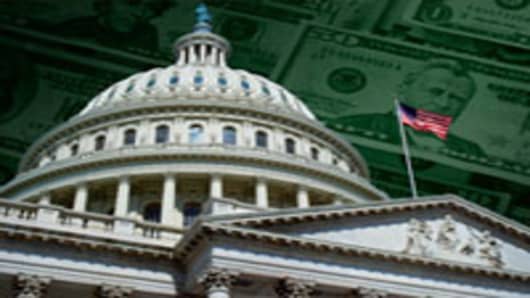“There's no way he has any information that's telling him that; he's just making it up,” I said.
I don’t think I added that the chairman of the House Budget Committee should not be making this kind of thing up. Forecasts about market reactions to debt defaults should be made based on very conservative assumptions. Or better yet, not made at all.
The United States government has never defaulted on its obligations to pay its debt. It has never, ever missed a payment. This is one of the reasons that “flights to quality” typically involve buying US Treasury debt. Uniquely in the history of sovereign borrowers, the United States has paid when it said it would pay.
Not everyone sees history this way. Over at Business Insider, Polycapitalist writes that the “U.S. has defaulted or 'restructured' (a partial-default) at least once every century since the founding of the republic.” He relies on Carmen Reinhart's and Ken Rogoff's research in their book “This Time is Different” to make this claim.
Reinhart and Rogoff give four examples of US defaults/restructurings.
Let’s run through each of them.
The 1790 Default. Shortly after the formation of the first United States federal government under the Constitution of 1787, Congress passed and President Washington signed the Funding Act of 1790. This act directed the Secretary of the Treasury, Alexander Hamilton, to assume the Revolutionary War debts of the states, allowing creditors to exchange the state-backed war debt with bonds issued by the US Treasury. The interest on the bonds was deferred until 1801. A total of $21.5 million dollars was assumed.
Prior to the passage of the Funding Act, much of the debt was expected to default. It traded at deep discounts to face value. Once the act was passed, the value of the debt skyrocketed—because bondholders were sure they would be repaid by the new federal government. In fact, quite a lot of money was made by people who bought the state debt in anticipation of the Funding Act or with early notice that it had passed. Even at the time of the Founding, traders were profiting from informational asymmetries.
The Act also provided that the debt securities issued by the Confederation government that existed prior to the federal government would be converted into new federal bonds. The interest on one third of the value of the converted bonds was deferred until 1801.
So why is this described as a default by Reinhart and Rogoff? It’s pretty clear that the federal government was not defaulting on its own obligations. Instead, it was modifying obligations incurred by the states—either directly or through the Confederation—and assuming them.
This was almost the opposite of a default, since it made payment much more likely. That’s why the bonds rallied after the passage of the act.
The 1841-1842 Defaults. This was actually a series of defaults by nine state governments, including three states that repudiated their debt altogether. The federal government was not involved.
The 1873-1884 Defaults. Another series of defaults by states and cities. In total 10 states defaulted. West Virginia, the worst of the state financial basket cases, was still working out its debt with creditors by 1918. There wasn’t a federal government default, however.
The 1933 Default. In the summer of 1933, Congress passed the “Joint Resolution to Assure Uniform Value to the Coins and Currencies of the United States” which declared invalid and provisions of obligations of the federal government which were “purported” to give the creditor the right to require repayment in gold. The Roosevelt administration wanted to depreciate the paper currency, and thought the “gold clauses” contained in various bonds were an obstacle.
This is arguably the closest the US government came to defaulting. But this is more like monetizing debt than defaulting. It is closer to having the Federal Reserve inflate our way out of debt than what Rep. Ryan is proposing.
So no history of defaults?
To be fair to Reinhart and Rogoff, they don’t describe these as pure defaults—but as instances of defaults and restructuring. In this paper, they give more details on them.
It’s just not correct to say that the US is a serial defaulter—or to imply that we can predict the consequences of a default now based on past defaults. We just don’t have any historical data to tell us what would happen.
___________________________________________
Questions? Comments? Email us atNetNet@cnbc.com
Follow John on Twitter @ twitter.com/Carney
Follow NetNet on Twitter @ twitter.com/CNBCnetnet
Facebook us @ www.facebook.com/NetNetCNBC



